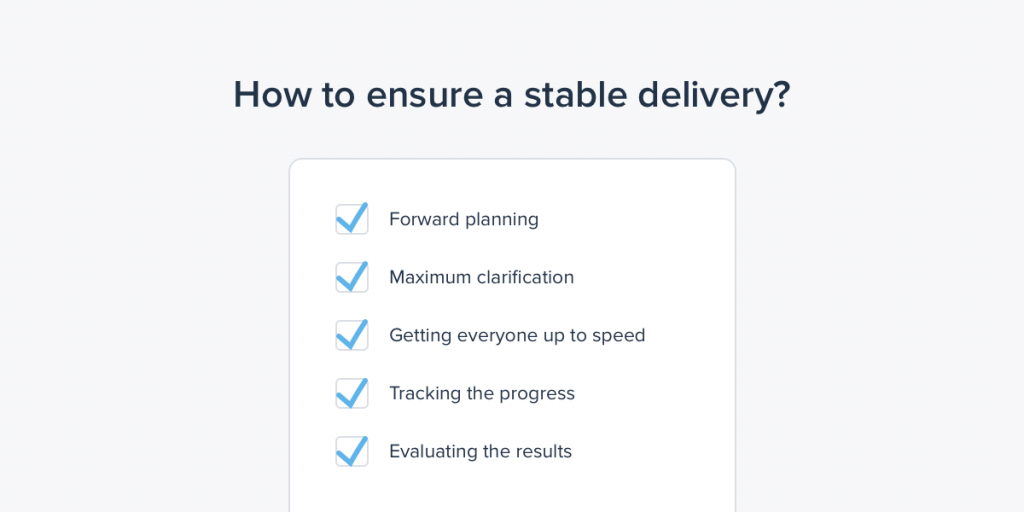

Community
If you’ve ever dealt with a software project before, you’ve likely heard the term ‘deliverable’ used here and there. But what is a key deliverable exactly? In this article, we’ll take a look at what deliverables are, what kinds of deliverables exist out there, why it’s important to clearly define them, and what you can do to ensure that your project achieves everything it has set out to do.
When you finish a part of a project, you deliver a certain result – that result is often referred to as ‘a deliverable’. But what are key deliverables? Key deliverables are essentially the major results that embody the main goals of the project as a whole. They are commonly tied to certain deadlines, and no project is considered complete until all its key deliverables are fulfilled.
Examples of key deliverables include:
Bigger deliverables are often split into smaller sub-deliverables, also known as releases. Each release has its very own deadline, and each needs to undergo testing and general quality assurance before it can be considered complete.
Additionally, it’s not uncommon for larger projects to have their deliverables split in a way that has different groups of people expecting different sub-deliverables. For instance, the main goal of an app being developed is for users to enjoy it – that’s the main deliverable. But to achieve that goal, the engineers that program it first need to get their own deliverable in the form of a design mockup from the UX/UI design team. The same goes for all other departments involved in production.
Deliverables come in many forms, so let’s take a brief look at some common types of deliverables that you may encounter during the development process.
Internal and external deliverables are defined by the recipient of your deliverables. If a deliverable needs to be submitted to your own company, it’s an internal deliverable. If you submit it to your client or your stakeholder, the deliverable is considered external.
Internal project deliverables usually include wireframes, workload reports, and budget reports. Initial app designs, time-tracking reports, and short-term progress reports can sometimes be internal, but are accessible to the client more often than not. External deliverables usually come in the form of broader progress reports, finalised designs, and the final product, among many other things.
Process deliverables are stepping stones on the way to creating product deliverables. These have to do with documentation, data sharing, planning, equipment, budget, and software used to achieve a certain result.
Let’s use painting a fence as an example: choosing the paint colour you’re going to apply to the fence is a process deliverable, while revealing the painted fence is a product one. Sure, one may not have the same satisfying effect as the other, but both are equally important for achieving the project’s end goal.
Process deliverables can include internal bug reports, Gantt charts, client onboarding checklists, design project management plans, etc. Product deliverables can look like fully-developed applications, websites, content strategies, complete architectural blueprints, and so on.
Key project deliverables must be clearly defined and easily quantifiable. If a deliverable doesn’t meet these criteria, it should either be rephrased, reworked, or completely omitted from the project plan. This process can be streamlined by implementing SMART goals, which is a practice that encompasses the principles of project aims being Specific, Measurable, Achievable, Relevant, and Time-bound.
Needless to say, tracking is integral in projects with multiple deliverables. It doesn’t require any sophisticated tools: good ol’ spreadsheets will do just fine, though a project management application can make the process a fair bit more intuitive. If you want to minimise the risk of having to deal with tons of vaguely related convoluted documents, a tool like that might be just what you need.
Regardless of the approach you choose, your process must be standardised in order to keep the pace and quality of the developers’ work consistent at every phase. But are there any tricks to ensuring the stability of your workflow?

There are a couple of things you should keep in mind to ensure that your deliverables are created effectively and with as little risk involved as possible. As obvious as some of these may sound, a good number of projects go under due to not following these very simple rules or dismissing key deliverables in project management. So let’s take a look at these often forgotten essentials.
If you have a place to be, you need to know how to get there. So if you have a project deliverable to create, you have to understand which steps need to be taken to achieve that. In that, a comprehensive plan is not unlike a travel map – the clearer it is, the more likely you are to get to the destination fast and safely.
Start with making a very important project management deliverable – the project charter: break your project down into its key objectives and define the deliverables based on that. Consider what the project is trying to accomplish, how it can be done, and what resources are necessary for it. It’s also good to consider your stakeholders’ point of view on the plan and the expenses required for its completion.
Now that you have the general plan down, you need to flesh it out. The devil is in the details, and taking a closer look at every aspect of the development process can shed light on some major risks or factors you may not have noticed from afar.
After getting the green light from your stakeholders, you can begin to devise the exact tasks needed to complete every deliverable, how long each of them will take, and what dependencies will be involved. A Gantt chart is one of the most common ways to organise this data, as it can easily integrate with different project management software, such as Backlog.
At this stage, you should pay special attention to what each given deliverable must achieve, its dependencies, its deadline, the resources needed to complete it within the required time frame, and the best methodologies to be used in the process of creating it.
A smooth workflow is impossible when everyone has a different idea of what the team is trying to achieve. You need to ensure that everyone involved in the project is on the same page in regards to what you’re doing, why you’re doing it, how you’re doing it, and how the overall progress is measured.
Allocate some time specifically to communicating the exact aims and key deliverables of the project to the team before starting development. Consider which specialists need to be involved and to what extent, think through how to best communicate the deliverables to the team, and contemplate whether some additional specialist training will be necessary before the kick-off.
Sooner or later, you’ll need to show your progress on the project to either your stakeholders, your clients, or other teams. That’s when all the downfalls of disjointed progress tracking will become apparent – unless, of course, you set some tracking guidelines for all teammates from the get-go.
Different collaboration software solutions tend to have features that help users reliably track progress, making it easy to monitor and compile progress data across many tasks in multiple departments. Automated reports can make presenting the necessary information to stakeholders and clients easier, as well as provide a comprehensive overview of your team’s actual progress in relation to the schedule.
Each deliverable release tends to be followed by a roundup meeting, where you and your team can discuss what went well, what went wrong, and what you can change to make the next round of the project better. Remember that these meetings must be as transparent as possible: no matter how unpleasant, the hard truth will always be more useful than any level of sugar coating.
So what are key deliverables? Deliverables are a direct reflection of the project’s goals and serve as concrete objectives for the developers to achieve. These can be tangible and intangible, but regardless of their form, the clearer the deliverables are, the easier it is to devise a stable work plan that will ensure the end product’s success.
The process of analysing and detailing key project deliverables can get rather complicated, which is why it’s not uncommon to hire more experienced specialists to effectively deal with it. If you are interested in improving your project planning and deliverables analysis, sign up for a free consultation with the experts of Bamboo Agile.
How useful was this post?
Click on a star to rate it!